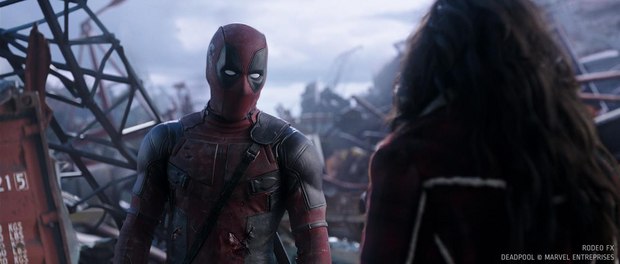Led by VFX supervisor Wayne Brinton, Montreal studio delivers grotesque skin transformation, Helicarrier crash sequence, set extensions, and complex sequences requiring fire and embers for Tim Miller’s R-rated depiction of the Marvel Comics anti-superhero.
MONTREAL -- Rodeo FX completed close to 230 VFX shots for Deadpool, Tim Miller’s R-rated depiction of the Marvel Comics anti-superhero. The studio, led by VFX supervisor Wayne Brinton, worked on complex sequences that required fire and embers, grotesque skin alterations, and set extensions. Rodeo FX brought its unique skills to this collaborative VFX effort, ensuring that the finished product was much more than the sum of its parts.
“I really appreciated the passion and artistry that Wayne and the Rodeo FX team brought to the show,” said Jonathan Rothbart, VFX supervisor on Deadpool. “Rodeo became one of my favorite facilities. They consistently did more than was asked, bringing their own sensibility and finish to the shots. I always felt like I was dealing with true artists who loved their craft. “

Brinton is a huge fan of Deadpool and brought his love and knowledge of the comics to the project. “Everyone at Rodeo FX was very excited to work on this movie,” he said. “Deadpool has amazing action sequences and still makes fun of the idea of superheroes.”
“Wayne knows this story inside and out and was able to propose ideas from the comics, which Jonathan took to the director,” said Jordan Soles, executive VFX producer at Rodeo FX. “Wayne’s insight into the canon and his enthusiasm were a huge asset for the team.”
Rodeo FX began working on the movie before production, helping to produce an amusing promo for April Fool’s last year, when the studio announced that Deadpool was going to have an R rating. Once shooting began, Rodeo FX was tasked with 100 shots, which grew to be almost 230 shots on two scenes over the course of postproduction.
Repulsive skin transformationThe mutation introduced into Wilson’s body changes the structure of his skin and, once he becomes Deadpool, he is hideous to look at without his tight red Spandex. Brinton and his team did concepts for skin decomposition at different stages, using time-lapse photography of rotting vegetables and meat for inspiration. They found that the production plates were too dark to show the subtleties of what they wanted to do, so they added more detail and shape to the skin, modeling with ZBrush, doing lighting passes, and finally compositing in the textures.

Wayne Brinton
“This was my favorite sequence to work on and the most satisfying,” said Brinton. “I knew we’d nailed it when the people around me in the theater gasped in disgust when they saw Deadpool’s skin mutation.”
Wilson is held in a torture chamber during this transformation, then escapes as the room burns to the ground. This scene was shot continually in one room that had been fitted with gas pipes emitting flames, making the usual practice of submitting individual shots for approval inefficient and awkward. Instead, Rodeo FX asked to submit the finished sequence in its entirety to Rothbart. This meant that every shot in the submitted sequence had to be final, with all shots at the same level of quality.
“At first this was nerve wracking for us and, I imagine, for the production team,” Brinton said. “But we knew that this was the most efficient way to complete this scene and it worked perfectly.”
Helicarrier crash sequence
The other main sequence that Rodeo FX worked on was a post-disaster scene in which a ship crashes, creating a junkyard of smoldering parts. The scene was shot against a greenscreen and then Rodeo FX generated set extensions for the junkyard, composited a matte painting that Blur Studio shared with them, and added smoke and ashes. Rodeo FX produced additional matte paintings based on photos of the set taken during production. The studio added lots of smoke and ashes at the beginning of the scene when everything is crumbling down, then reduced the intensity as the scene progressed.
“We aimed for a choreography of simulated ash, falling in 3D space,” said Martin Lipmann, compositing supervisor at Rodeo FX. “It’s seemingly minor elements like this that ensure the continuity and believability of a scene like this.”
“It’s great when we get a magical production like Deadpool,” Soles said. “The project flew through the facility, with overall excitement among the whole team. It was like that from day one. We’re proud to be a collaborative team that delivers without drama. Even toward the end, when deadlines could have got overwhelming, we were still having fun and getting it done.”
Distributed by 20th Century Fox, Deadpool was directed by Tim Miller and stars Ryan Reynolds, Brianna Hildebrand, and Ed Skrein. The film saw theatrical release on Feb. 12.
Source: Rodeo FX










